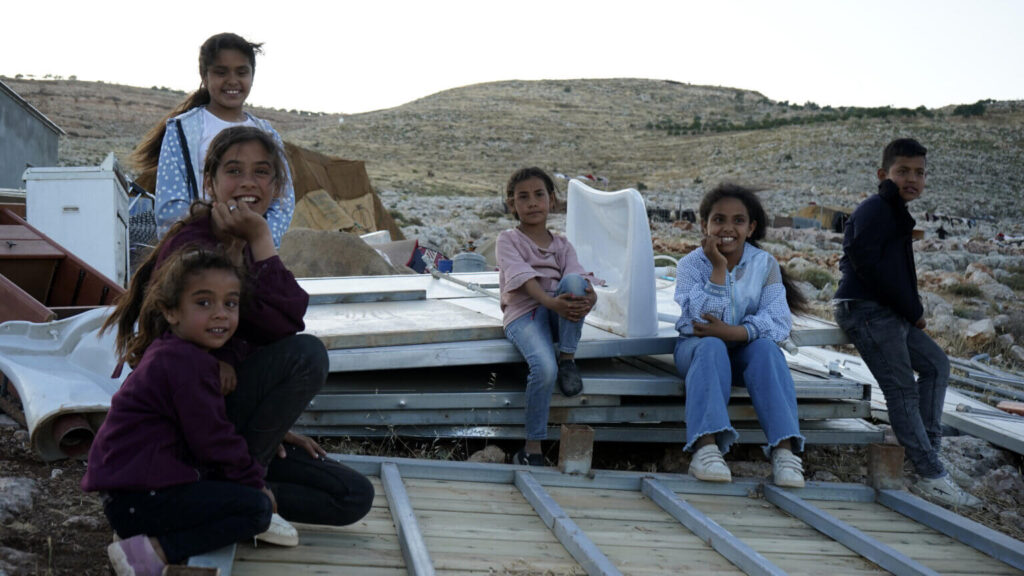The Slow Ethnic Cleansing of Ein Samiya’s Bedouin Community
PALESTINE - ISRAEL, 5 Jun 2023
Mariam Barghouti | Mondoweiss - TRANSCEND Media Service
Israeli settlers and military systematically made life unbearable for the Bedouin community living in the West Bank’s Ein Samiya region. On May 22 they were forced to leave their lands and were displaced for the fourth time since 1969.
31 May 2023 –On Monday, May 22, at least 16 Palestinian families (almost 170 people) were forcibly expelled from their homes near the Ein Samiya spring and the Palestinian village of Kufr Malek, 27 kilometers northeast of Ramallah.
The spring is wedged between Kufr Malek and the illegal Jewish-only colony of Kohav HaShahar and the nearby illegal outpost of Moaz Ester. The Bedouin community, part of the Ka’abneh clan, has lived in that area for more than three decades, comprising 16 families living as herders and working in agriculture.
On Wednesday evening, May 24, the Ka’abneh clan finished moving the last of their belongings to a new location a few hundred meters away from their former homes. It was a forced resettlement following weeks of settler and police harassment that made life unbearable for the community.
“What happened yesterday was a neo-Nakba,” Abu Najeh Ka’abneh, 81, told Mondoweiss on Thursday evening outside of the village of al-Mughayyir, where the community had relocated.
“Record, record,” Abu Najeh said firmly. “Don’t get the information wrong. I’ll speak slower, but focus and write.”
Sitting among a circle of men from his community as children dart in and out of the main sitting tent, Abu Najeh spoke with frustration and fear as he recounted the harrowing experience of the past week.
“The attack on Monday, May 22, was preceded by several days of continuous harassment,” Abu Najeh told Mondoweiss. “On May 16, settlers came and stole 37 sheep from our community in Ein Samiya, and I called the Red Cross to help us,” he said.
Abu Najeh had reached out to the Red Cross because the Israeli police had assaulted a 51-year-old herder from the community on May 16, claiming that his sheep belonged to one of the settlers of the Kohav HaShachar settlement.
“When the herder, Ata, wanted to say something, the police handcuffed him,” Abu Najeh said, taking a deep breath before continuing. “And when the herder — he’s the owner of the sheep — used his phone to try and call one of us, the police took it from him.”
The community’s youth eventually saw the altercation with the police and spread the news about the incident until it reached Abu Najeh. “This is a kidnapping, no?”
According to the community members, Ata was released at around 9:00 p.m. on Tuesday, the 16th. “He was fined 1500 shekels, and his 37 sheep were never returned,” Abu Najeh testified. “The price of a single sheep is between 1200-2000 shekels. Do the math,” Abu Najeh said, repeating once more the number of sheep stolen: “Thirty-seven.” The man’s entire livelihood depended on the livestock, with a family of 20 dependent on him for their daily needs.
A few days later, Abu Najeh and 170 others in his community were forced to pack up what they could manage to carry from their homes and belongings.
“As Palestinians, who must protect us? Shouldn’t it be our representatives?” Khader Ka’abneh, another member of the Bedouin community, told Mondoweiss. Standing up from his seated position, Khader began to release his pent-up indignation. “Unfortunately, during the Oslo Accords, our issues were not discussed, and what we experienced days ago is an even bigger Nakba.”
For the Bedouin communities across Palestine, the herding lifestyle they uphold allows them to travel around Palestine’s landscape, further solidifying the presence of Palestinians in various areas around Jericho, the Jordan Valley, and the Mua’arajat — all at risk of Israeli annexation. Yet the burdens of surviving, coupled with the internalization of a feeling of duty towards protecting the land from settler theft, weigh heavily on Palestinian Bedouins.
“That was the only home my family has known,” Umm Najeh, Abu Najeh’s wife, told Mondoweiss as she sat on a plastic chair in a newly erected Bedouin tent less than 12 hours after the expulsion. “I have given birth to all eight of my children on that land.”
Umm Najeh’s eldest son is 32 years old, and her youngest is 12. Neither knows a home outside of the hills they have wandered with their sheep near Kufr Malek their entire lives.
“The children are constantly afraid of them,” Umm Najeh said as Jamal, 12, passed the tent where she and other women from the community sat, rebuilding their homes and arranging what little remained of their belongings.
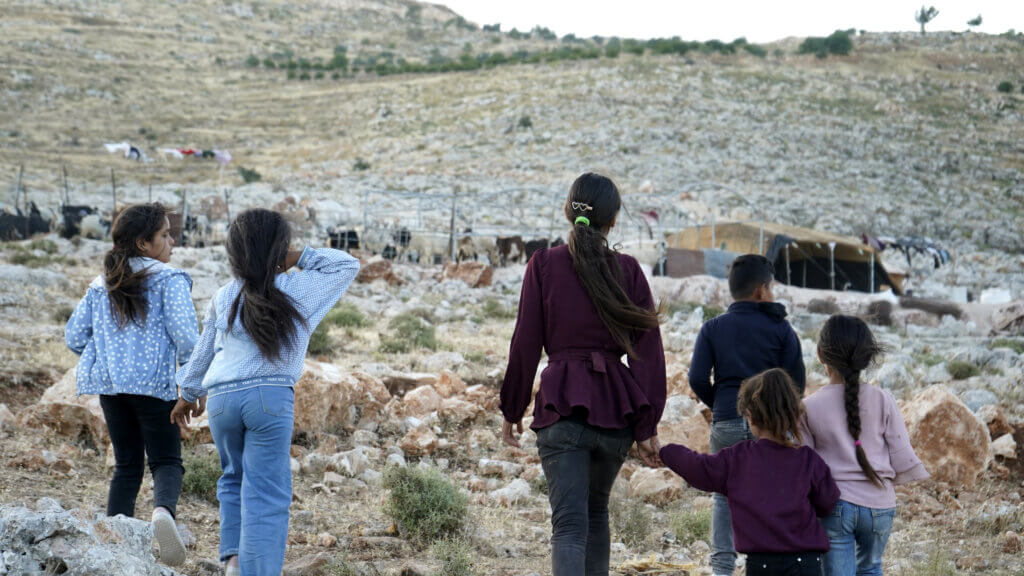
Slow ethnic cleansing
“The settlers just kept coming more often, every night and almost daily,” Umm Najah told Mondoweiss as she washed and chopped some parsley for dinner.
“Look, before we used to be able to call the police to interfere when settlers attack,” Abu Najeh explained. “Now, in the last two years or so, the police themselves have been initiating the assaults.”
According to the community, Israeli border police have not only been guarding settlers during their rampages but have at times directly joined in on the violence. “If the police saw our blood spilling in front of them from the settlers, they would still call us liars,” Abu Najeh explained.
Palestinian Bedouins mostly live in Area C, which according to the Oslo Accords comprises more than 65% of the West Bank, and is under settler and Israeli military rule. This means that the Palestinian Authority (PA) has no jurisdiction in the area, so for Palestinian Bedouins, the only recourse in the face of settler violence is to appeal to the Israeli authorities.
In addition to the intensified violence to which the Ka’abneh community has been exposed over the past five years, the Bedouin clan has also become financially drained due to the theft of their sheep and livestock. Coupled with settlers’ night incursions aiming to push them out, they were eventually forced to relocate to the village of al-Mughayyer — the product of a policy of slow ethnic cleansing by making life so unbearable that they leave.
The community fears they may be seen as having given up on their lands in Ein Samiya. “There are people that say we just chose to leave,” Khader told Mondoweiss, in a voice more angry than pained. “I see on social media, some said we just chose to leave. But those five years of settler attacks on our children and women, that was enough pain. That was enough,” he said.
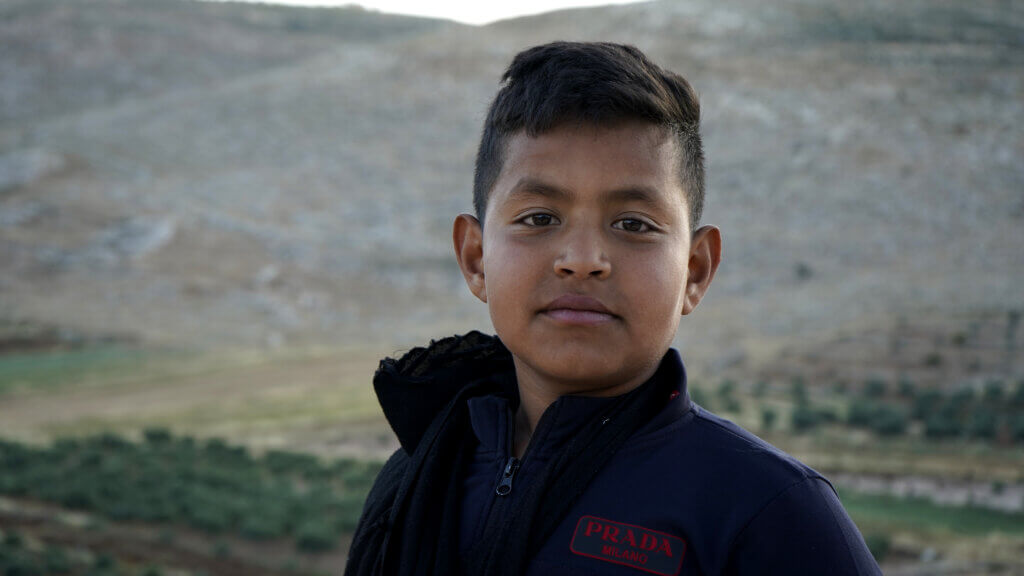
(Photo: Majd Darwish/Mondoweiss. May 25, 2023)
At that moment, his 12-year-old son Jamal held up his arm, hiding underneath a black scarf tied to his neck, serving as a makeshift sling — he had broken his arm running away from settlers in the moments leading up to the community’s violent expulsion on May 24.
“We couldn’t take it anymore. I swear, I promise, if we had support — at least take the women and children to keep them safe — we would have stayed and remained guardians of the land,” Khader said.
“Yesterday was the biggest Nakba we experienced,” Abu Najeh said. “Look at us, we don’t know how to sit, how to eat.”
“In two days, we had to rebuild a home,” Umm Najeh pointed to the cluster of small metal barracks and tents which now served as the community’s temporary home. “Look at this, we were able to at least rebuild these rooms for receiving guests, and here we are with the grace of God, rebuilding still,” she said with a smile that seemed to hold back a flow of tears.
‘The settler is the state, and the state is the settler’
During the first three months of 2023, Israeli settlers in the West Bank escalated their attacks on Palestinian farmers and herders. The Israeli human rights organization, B’tselem, recorded at least 108 different incidents where settlers, often joined by the police or the military, assaulted farmers, uprooted trees, and beat Palestinian civilians and children. As for the year before that, 2022 saw a record high of settler attacks in the West Bank, while between 2010 and 2019, thousands of settler attacks were also recorded. In February of this year, Israeli settlers committed a pogrom in the Palestinian town of Huwwara outside of Nablus, killing a Palestinian man, injuring dozens, terrorizing thousands in an arson rampage, and costing millions of shekels’ worth of property damage.
The displacement of the Bedouins of the Ein Samiya region is a part of this trajectory of rising settler violence, but it is also tied to the evolution of the neighboring settlements of Moaz Esther and Kohav HaShachar.
The Kohav HaShahar settlement, founded in 1980 for 280 Israeli settler families, is situated between the Palestinian towns and villages of Ramon, the final Palestinian town before the Jordan Valley. Currently, over 400 settler families live in the settlement, which advertises itself as a “religious settlement with a community that permeates warmhearted and caring family life.”
On the other hand, the Moaz Esther illegal outpost is marketed as the only “all-girl hilltop” promoting women’s participation in settlement expansion as a duty incumbent upon every Jewish person. The outpost was founded in 2006 in memory of Esther Galia, killed in a drive-by shooting near the settlement of Rimonim at the peak of the Second Intifada when Israeli forces committed crimes against humanity in the West Bank and Gaza.
By February 2020, Israeli authorities and police had dismantled two Israeli settler tents at the illegal outpost of Kohav HaShachar, clashing with settlers and arresting at least one rioter who hurled stones and assaulted police. However, following the Unity Intifada of 2021, when Palestinians engaged in collective mass mobilization from the river to the sea for the first time in decades, Israeli violence from settlers and the army increased. At the time, Benjamin Netanyahu, who was facing corruption charges, gave the green light for joint settler, military, and police violence against Palestinians.
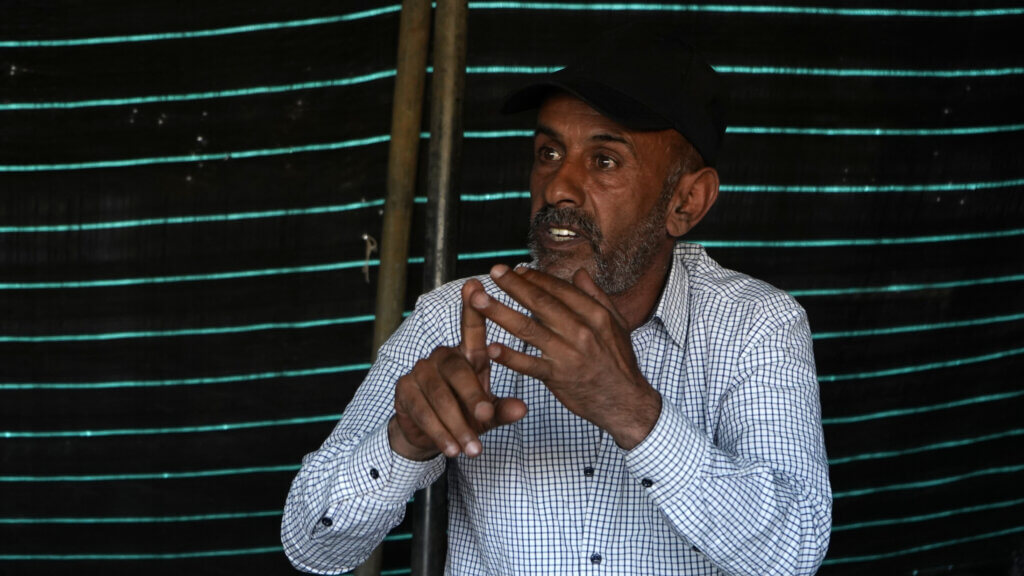
(Photo: Majd Darwish/Mondoweiss. May 25, 2023)
“You need to focus, and please understand,” Khader Ka’abneh tells Mondoweiss. “The settler is the state and the state is the settler. They are one and the same.”
While Israel has attempted to separate the settlers in the West Bank from those in the army, Israeli policymakers represent settler aspirations. Those aspirations have tended to gather steam during periods of heightened Palestinian resistance. In 2018, for instance, then Agriculture Minister Uri Ariel had vowed that “our revenge is settlement and holding tight to the land,” which he said following the stabbing of Israeli settler Adiel Kolman during the peak of Israel’s attempts to solidify control over East Jerusalem.
“I hope we’ll continue to advance construction in Jerusalem and Judea and Samaria and make a clear decision that between the Jordan [River] and [Mediterannean] Sea there will only be one sovereign state — the State of Israel,” Ariel affirmed alongside Nir Barakat, then Mayor of Jerusalem.
Abu Najeh confirmed that period as one of heightened settler and military theft of land and property. “In the last five years, the police have been bringing settlers who have sheep, and they would come to those herding areas,” Abu Najeh explained.
A lifetime of expulsions
Tender and shy, Umm Najeh laments the lands she has known for over three decades. “That was my home, a dear place to me,” she told Mondoweiss. “I had all my eight children on that land,” she said. “Here we are now, displaced.”
Unlike Umm Najeh, the most recent expulsion, and the string of harassment and theft that preceded it, is not where the story of Abu Najeh begins — he has been forcibly expelled from his land four times ever since 1969.
“Pay attention. Record,” Abu Najeh reiterated as the 81-year-old narrated the trail of dispossession that colored his life. “I was born in the area of Hebron, and grew up in al-Ouja, where I stayed until 1967, when we were given documents to stay there.”
Al-Ouja, an area ten kilometers north of Jericho consisting of the Ouja valley, receives a stream of water originating from Ein Samiya near Ramallah. From there, the Ouja stream flows into the Jordan River. Due to the herding lifestyle of Bedouin communities, natural water sources and their relationship with the wider ecosystem dictates how they select their area of living.
“In September of 1969, [Israeli authorities and forces] gave us 24 hours to gather everything and leave for the Ramallah area,” Abu Najeh said, recalling his first experience of expulsion. That September was when the Ka’abneh community moved to the Mua’rajat area near Ramallah.
Six months later, in March of 1970, the community was forced out of their homes again, marking Abu Najeh’s second experience of expulsion.
“It was raining and [the army] came and began forcing us out. They did it in the rain.” The Israeli army was pushing the family out under the pretext of using the area for military purposes. “[The military] took us almost 3-4 kilometers away in their vehicles,” Abu Najeh recalled.
“They practiced on us, on our homes, so they can drive us out.”
— Abu Najeh
Israeli authorities displaced the community to an area 500 meters away from where they began building a new home six months earlier. This pushed them further into Ramallah, but the terror campaign didn’t stop there.
“Four or five military tents came and stayed for three or two months,” Abu Najeh said. “Then they came and started shooting bullets at us and our homes. The bullets would enter the homes and the children would run,” Abu Najeh said. “[The soldiers] left all the empty lands around us and began shooting in our direction,” Abu Najeh said bitterly. “You understand why? So they can expel us, drive us out,” he said.
That was when their third expulsion took place, as the Ka’abneh clan escaped the Mu’arajat under Israeli gunfire and resettled in the Ein Samiya region. Before the fourth and most recent expulsion in May of this year, the community had spent several uninterrupted decades living near Ein Samiya. “Allah kept us safe from them, and so we managed to go to Ein Samiya, where we have been since the 70s,” Abu Najeh said, his tone betraying a nostalgia for the home that he has now known for decades.
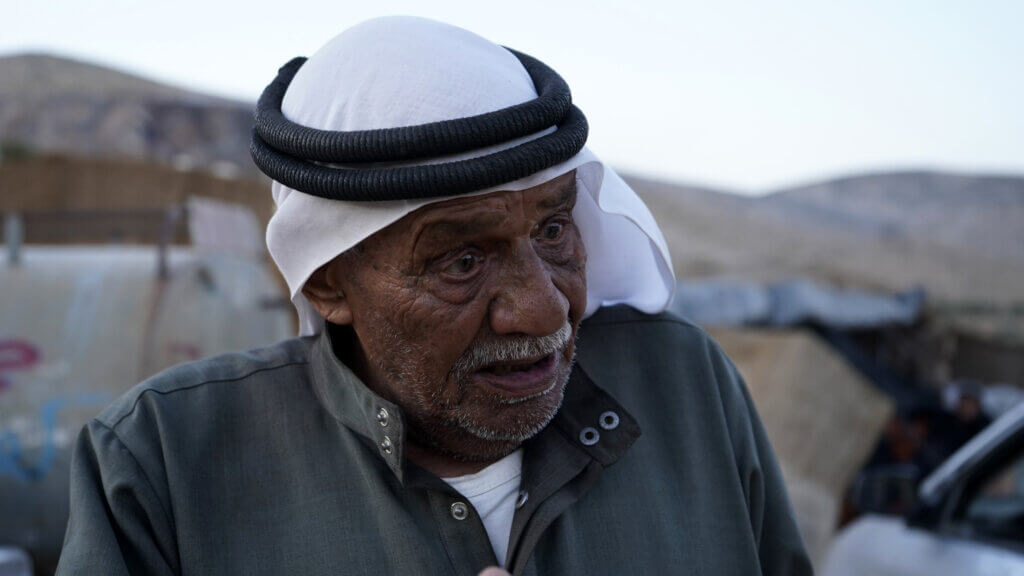
(Photo: Majd Darwish/Mondoweiss. May 25, 2023)
During their third expulsion in 1970, the Israeli army had converted their lands in the Mu’arajat region into closed military “firing zones.”
“They practiced on us, on our homes, so they can drive us out,” Abu Najeh said.
This policy of building “firing zones” and “military bases” continues to this day as an instrument of slow ethnic cleansing, sectioning off vast swathes of land for military use and hence justifying land theft based on “national security” needs.
In the Jordan Valley and Dead Sea areas in Jericho, Israeli authorities declared almost half of the region as a “firing zone.” These areas, which have the largest land reserves, constitute almost a third of the West Bank and are home to almost 80,000 Palestinians, 15,000 of whom are Palestinian Bedouins, sprawled across a few dozen community clusters. All of them are slowly being driven toward Ramallah.
“Indirect and direct forcible transfer is currently at the forefront of Israel’s ideological agenda in area C,” a report published by MAAN Development Agency in 2015 reported. “Firing zones, initially established as a means of land control, are now being used to create an environment so hostile that Palestinians are forced to leave the area or live in conditions of deteriorating security,” the report concluded.
The web of experiences tracing four different expulsions allows Abu Najeh to judge the unfolding of the Israeli state’s ethnic cleansing project over the years. “This year is worse than the war of 1967,” he said.
Losing to the ongoing Nakba
The experiences of the Ka’abneh clan have taught them that this recent expulsion will not be their last.
“Tomorrow is darker than today, and the day after will be darker than tomorrow,” Abu Najeh said bitterly around a group of men from his community the day after the expulsion from Ein Samiya.
The community’s skepticism of a less violent future stems from the repeated memories of expulsion and assault by settlers. In the early 1970s, almost as soon as the Ka’abneh clan found some stability in Ein Samiya, Israeli courts began pushing one expulsion order after another. The community has spent year after year fighting them in court.
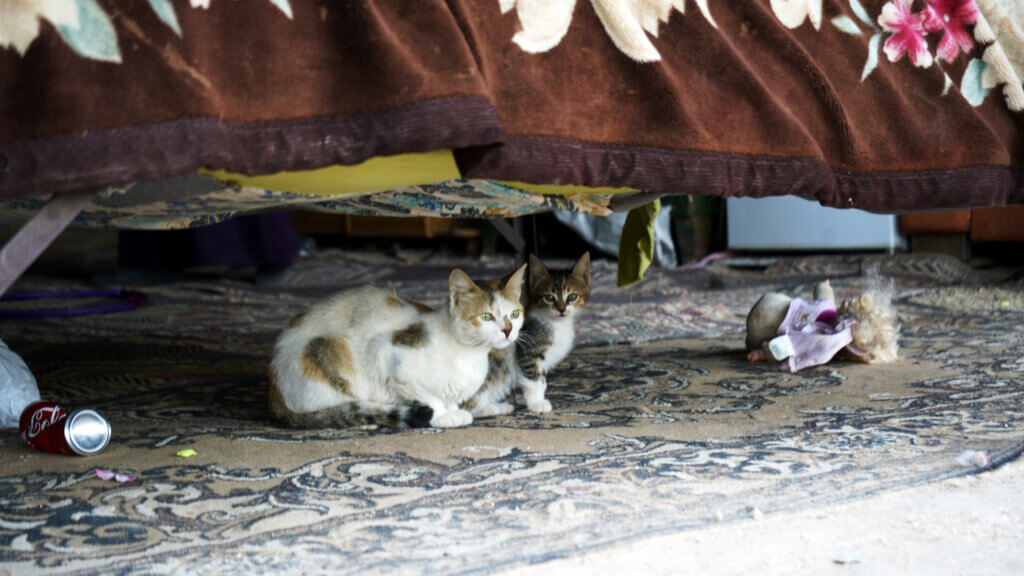
(Photo: Mariam Barghouti/ Mondoweiss May 25, 2023)
“Since 1980 we have been fighting through courts against every expulsion order,” Abu Najeh told Mondoweiss. The orders from Israeli authorities for the expulsion of the community began in 1974, according to Abu Najeh.
This year, mirroring the experience of the Ka’abneh clan, other Bedouin communities in the Mu’arajat area were forced to leave their homes in February of this year, also relocating due to the severity of the attacks by Israeli forces and the lack of protection.
As for the Ka’abneh community, their relocation to the village of al-Mughayyir near Ramallah has put them in hostile terrain. Shortly after the clan arrived in the village, Israeli settlers attacked al-Mughayyir and its farmers. At around that same time, Palestinians faced a wave of lethal violence from Israeli settlers and the army in other West Bank towns and villages.
This has only further cemented the conviction that no place is safe from Israeli colonists.
For Palestinians, this is nothing new and is seen as a continuation of what started in 1948. And while Palestinians have witnessed the resurgence of resistance to Israeli colonialism across the West Bank since early 2022, some communities have been unable to withstand the constant harassment and daily indignities of colonial erasure.
“I cannot resist the Israeli state alone,” Khader Ka’abneh told Mondoweiss, reiterating his earlier statement: “The settler is the state. The settler is the government. I can’t fight that alone.”
Ata, the 51-year-old herder, echoed the disappointment, admitting that he can longer fight the settler attacks. “I have been trying these past five years, and I can’t anymore.”
______________________________________________
Mariam Barghouti is the Senior Palestine Correspondent for Mondoweiss.
Tags: BDS Boycott Divestment Sanctions, Colonialism, Cultural violence, Direct violence, Ecocide, Gaza, Genocide, Israeli Apartheid, Israeli Army, Israeli occupation, Middle East, Nakba, Palestine, Palestine/Israel, Sociocide, State Terrorism, Structural violence, Violent conflict, West Bank, Zionism
Join the BDS-BOYCOTT, DIVESTMENT, SANCTIONS campaign to protest the Israeli barbaric siege of Gaza, illegal occupation of the Palestine nation’s territory, the apartheid wall, its inhuman and degrading treatment of the Palestinian people, and the more than 7,000 Palestinian men, women, elderly and children arbitrarily locked up in Israeli prisons.
DON’T BUY PRODUCTS WHOSE BARCODE STARTS WITH 729, which indicates that it is produced in Israel. DO YOUR PART! MAKE A DIFFERENCE!
7 2 9: BOYCOTT FOR JUSTICE!
DISCLAIMER: The statements, views and opinions expressed in pieces republished here are solely those of the authors and do not necessarily represent those of TMS. In accordance with title 17 U.S.C. section 107, this material is distributed without profit to those who have expressed a prior interest in receiving the included information for research and educational purposes. TMS has no affiliation whatsoever with the originator of this article nor is TMS endorsed or sponsored by the originator. “GO TO ORIGINAL” links are provided as a convenience to our readers and allow for verification of authenticity. However, as originating pages are often updated by their originating host sites, the versions posted may not match the versions our readers view when clicking the “GO TO ORIGINAL” links. This site contains copyrighted material the use of which has not always been specifically authorized by the copyright owner. We are making such material available in our efforts to advance understanding of environmental, political, human rights, economic, democracy, scientific, and social justice issues, etc. We believe this constitutes a ‘fair use’ of any such copyrighted material as provided for in section 107 of the US Copyright Law. In accordance with Title 17 U.S.C. Section 107, the material on this site is distributed without profit to those who have expressed a prior interest in receiving the included information for research and educational purposes. For more information go to: http://www.law.cornell.edu/uscode/17/107.shtml. If you wish to use copyrighted material from this site for purposes of your own that go beyond ‘fair use’, you must obtain permission from the copyright owner.
Read more
Click here to go to the current weekly digest or pick another article:
PALESTINE - ISRAEL:
